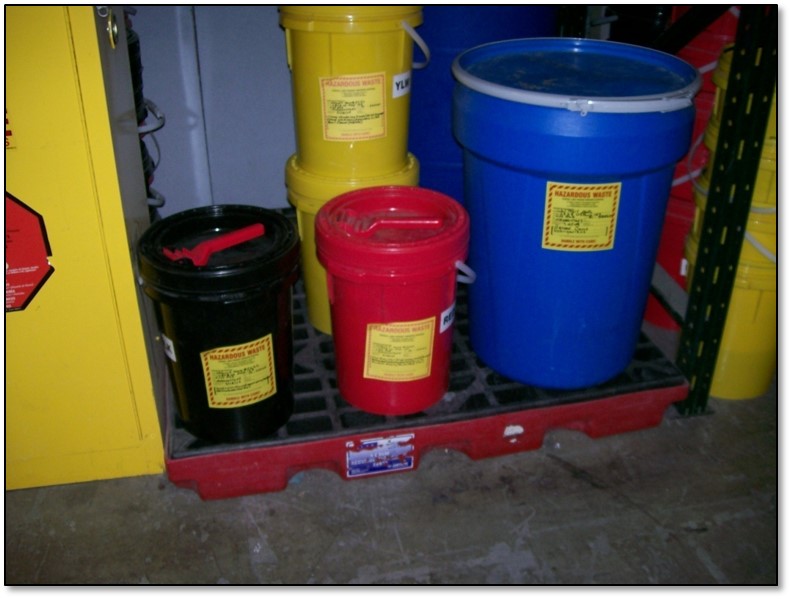The satellite accumulation area (SAA) regulations provide an option for generators to manage hazardous waste containers instead of in a central accumulation area (CAA). Containers managed in a SAA are not required to comply with many of the regulations applicable to the large quantity generator (LQG) and small quantity generator (SQG).
Revisions to these regulations by the Generator Improvements Rule now clarify the option to manage hazardous waste in a SAA and the relief from regulation it provides.
The purpose of this article is to explain the rewording of 40 CFR 262.15(a) clarifying the generator option to manage hazardous waste in a SAA or CAA.
Before we begin…
- This is one article in a series that reviews all of the changes made to §262.15 by the Generator Improvements Rule.
- The location of these regulations within Title 40 of the Code of Federal Regulations (CFR) was changed by the Generator Improvements Rule. The satellite accumulation area regulations were located at 40 CFR 262.34(c), they are now found at 40 CFR 262.15.
- FAQ: What is a satellite accumulation area?
- FAQ: What is a central accumulation area?
Scope and Applicability:
- Accumulation of hazardous waste in a SAA is an option for both a large quantity generator of hazardous waste (LQG) and a small quantity generator of hazardous waste (SQG). Very small quantity generators of hazardous waste (VSQG) don’t have to comply with SAA regulations per §262.14(a).
Not sure of your hazardous waste generator category? |
- These new regulations were created by the Generator Improvements Rule, which may not yet be adopted by your state. FAQ: What is the status of the Generator Improvements Rule in my state?
- A generator may accumulate either or both of the following in a SAA:
- Acute hazardous waste
- Non-acute hazardous waste (aka: hazardous waste).
40 CFR 262.15(a):
(a) A generator may accumulate as much as 55 gallons of non-acute hazardous waste and/or either one quart of liquid acute hazardous waste listed in §261.31 or §261.33(e) of this chapter or 1 kg (2.2 lbs) of solid acute hazardous waste listed in §261.31 or §261.33(e) of this chapter in containers at or near any point of generation where wastes initially accumulate which is under the control of the operator of the process generating the waste, without a permit or interim status and without complying with the requirements of parts 124, 264 through 267, and 270 of this chapter, provided that all of the conditions for exemption in this section are met. A generator may comply with the conditions for exemption in this section instead of complying with the conditions for exemption in §262.16(b) or §262.17(a), except as required in §262.15(a)(7) and (8). The conditions for exemption for satellite accumulation are:
Interested in a Webinar that covers this topic, and more! |
What’s it mean?
- Management of hazardous waste containers in a SAA is an option for generators, “A generator may…” (emphasis added).
- Provided the generator complies with the conditions of exemption for a SAA found in §262.15, it is not required to comply with the following:
- The LQG regulations for hazardous waste accumulation at §262.17(a).
Or…
- The SQG regulations for hazardous waste accumulation at 262.16(b).
Also…
- The RCRA permit programs of Part 124.
- Standards for Owners and Operators of Hazardous Waste Treatment, Storage, and Disposal Facilities of Part 264.
- Interim Status Standards for Owners and Operators of Hazardous Waste Treatment, Storage, and Disposal Facilities of Part 265.
Read: What’s the Difference Between Parts 264 and 265 of 40 CFR?
- Standards for the Management of Specific Hazardous Wastes and Specific Types of Hazardous Waste Management Facilities of Part 266.
- Standards for Owners and Operators of Hazardous Waste Facilities Operating Under a Standardized Permit of Part 267.
- EPA Administered Permit Programs: The Hazardous Waste Permit Program of Part 270.
And finally…
- Is not required to have a permit or interim status.
In sum, a generator that chooses to manage hazardous waste in a SAA and complies with its conditions of exemption is not subject to any other regulations of a hazardous waste generator…
Except…
- The requirements for preparedness, prevention, and emergency response referred to at §262.15(a)(7) for a SQG and §262.15(a)(8) for a LQG.
- The land disposal restrictions of Part 268.
Contact me with any questions you may have about the generation, identification, management, and disposal of hazardous waste Daniels Training Services, Inc. 815.821.1550 |
Conclusion:
This rewording of the regulations makes no practical effect on a hazardous waste generator’s compliance, it merely clarified existing regulations and maintained consistency of language between related regulations. But, someone had to write the article and here it is. If you’ve read this far, be sure to send me an email and let me know if you found it helpful. And why!

